I either hear “MAT Pilates is easy, I want to take a Reformer class” or “MAT Pilates is too hard for me!” We obviously need to clarify what MAT Pilates is all about!
Pilates as a whole is never too easy or too hard if you are connecting your mind, body and breathe together to do the movement. Yes, there may be some movements that are easier for you and harder for others depending on what’s going on with your body. Remember that the reformer, tower, chair and other apparatus are amazing and fancy pieces of equipment that provide you with resistance but they also assist you in a lot of areas. Give your body a different challenge without the assistance of the straps or springs!
MAT Pilates requires only one thing, yourself! It is great because you can take home what you learn in class without needing any of the fancy equipment. A lot of the MAT work exercises are original Joseph Pilates moves, the founder of Contrology or better known as Pilates! Joseph Pilates was a pioneer in his time. He believed that mental and physical health are interconnected and that eating healthy and getting sufficient sleep were essential for overall health. It feels kinda’ nice kickin’ it old school with JP! Some of those more classical Pilates exercises require you to work hard to stabilize your core, lengthen those muscles and control your pelvis. Oh yes, and don’t forget to breathe!
You will be in for an exercise routine that tones, strengthens, boosts mental health, improves posture, increases flexibility and focuses on your powerhouse – you know those really important muscles like your abs, pelvic floor musculature, hips and glutes. Remember, a strong core helps ward off back pain and makes daily chores more doable. A strong core is a must and not just for athletes! For parents picking up their kids, runners, golfers and those who sit at a desk or in their car for long periods of time. When your core is strong, it serves as the center of power so your limbs don’t have to bear as much of the brunt of movement. Studies show that Pilates is effective in reducing pain and improving function in people with back pain. How amazing is Pilates?! We can tell you stories of how Pilates saved numerous people from having to have back surgery.
Don’t be intimidated by the classical MAT Pilates repertoire, At Firehaus Pilates we may switch it up and start with a different warm up then “the hundred” and end with some nice fluid, feel good movement that relax the nervous system. We will always keep the movements appropriate for your body and skill level while still providing you with a challenging workout. Thanks to the balance, focus and strength work in Pilates, you will always leave the MAT feeling strong, energized and de-stressed. Amen to that!
So, if you have you been layin’ all comfy on the Reformer, get yourself into a MAT class and see where that body weight work is at! It takes a lot of control and strength but remember that Pilates of any type is for Every-BODY. Just as we modify movements on the reformer or tower, we also modify on the MAT! I challenge you to take 1 MAT class per week for 1 month and feel the difference in your body, mind and bootay!
We offer a MAT Class every Wednesday night at 7pm – For March MATness we are offering a 4 Pack of MAT Classes for $50.00. We encourage you to use them consecutively!
Home Work! Please feel free to take this exercise home with you along with anything else you learn in our classes!
The most commonly known Pilates MAT exercises is The Hundred:
Start lying on your back.
- Bend your knees so the feet are flat on the floor. Place your arms straight beside your torso with palms facing down.
- Take a breath in and on the exhale draw your navel into your spine (narrowing your waist as if you were wearing a corset). Then slowly bring your legs up to a tabletop position (lift one leg at a time keeping your abdominals engaged, the knees will be bent at a 90-degree angle and form a 90 degrees angle with your hip joint).
- Reaching with your arms, nod your chin and curl your torso to bring your head and neck off the floor. Beginning pumping your arms at your sides. Inhale for 5 beats, Exhale for 5 beats. Repeat this 10 times.
- To advance the exercise – extend your legs to a straight leg position.
Special considerations:
- Neck pain – Don’t work through it! You can perform all or part of the repetitions with the head on the MAT.
- Back pain – This is an indication that there is too much load on your abdominals (i.e. they aren’t strong enough yet). Make the position smaller: If your legs are straight, put them in tabletop; If your legs are in tabletop, place the feet on the floor.



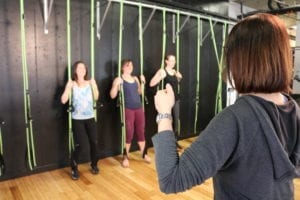 Ready for a workout like nothing else you’ve experienced? Try the Firewall with Bodhi Suspension! Firehaus Pilates is excited to be the only Denver and Colorado location that offers the unique Bodhi Suspension System. Unlike TRX Suspension training, this advanced strength-building class is a four-point suspension system that uses both your hands and feet to focus on balance and defining muscles from head to toe! Not for the faint-of-heart, the Firewall Suspension will push you harder than ever!
Ready for a workout like nothing else you’ve experienced? Try the Firewall with Bodhi Suspension! Firehaus Pilates is excited to be the only Denver and Colorado location that offers the unique Bodhi Suspension System. Unlike TRX Suspension training, this advanced strength-building class is a four-point suspension system that uses both your hands and feet to focus on balance and defining muscles from head to toe! Not for the faint-of-heart, the Firewall Suspension will push you harder than ever!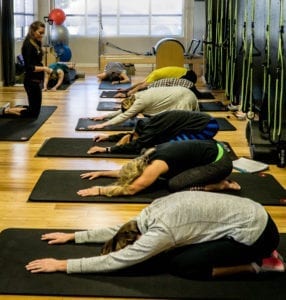 This class does not slow down! Expect a high energy hour of challenging Pilates exercise using a variety of equipment. You’ll condition your entire body, burn calories, improve your cardio, and have a great time. There’s additional focus on balance and core control to avoid injury and reduce joint pain. Designed for those experienced in Pilates, expect improved posture, alignment, and body awareness!
This class does not slow down! Expect a high energy hour of challenging Pilates exercise using a variety of equipment. You’ll condition your entire body, burn calories, improve your cardio, and have a great time. There’s additional focus on balance and core control to avoid injury and reduce joint pain. Designed for those experienced in Pilates, expect improved posture, alignment, and body awareness!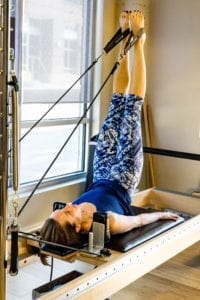 Central to all Pilates exercise, you can expect to engage, build, and strengthen your core muscles with targeted workouts. Strong abdominal muscles help stabilize you and improve your balance as you pivot, turn, and twist down the mountain. Pilates is a great form of exercise to strengthen your core muscles that will, in turn, support your skiing and stabilize you on each run.
Central to all Pilates exercise, you can expect to engage, build, and strengthen your core muscles with targeted workouts. Strong abdominal muscles help stabilize you and improve your balance as you pivot, turn, and twist down the mountain. Pilates is a great form of exercise to strengthen your core muscles that will, in turn, support your skiing and stabilize you on each run.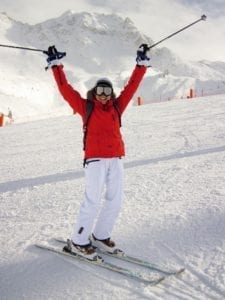 If you’re not sure what your quadriceps are before skiing or snowboarding, you’ll be aware of them afterward! The quads are the large muscles on the front of the thighs that connect the hips to the knees. For skiing and snowboarding, it’s important to build these muscles as they are so highly used during snow sports.
If you’re not sure what your quadriceps are before skiing or snowboarding, you’ll be aware of them afterward! The quads are the large muscles on the front of the thighs that connect the hips to the knees. For skiing and snowboarding, it’s important to build these muscles as they are so highly used during snow sports.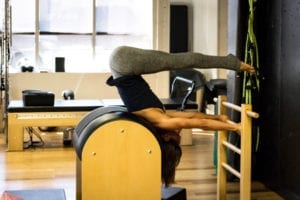 The gluteal muscles are made up of three muscles: the gluteus maximus, gluteus medius, and gluteus minimus. All three muscles form the buttocks, and the combined, make up one of the largest muscle groups in the body, and you use them all day, every day. However, as glutes help you rotate, move, lift, and thrust your legs and hips, if they are weak, they can cause an increased risk of injury.
The gluteal muscles are made up of three muscles: the gluteus maximus, gluteus medius, and gluteus minimus. All three muscles form the buttocks, and the combined, make up one of the largest muscle groups in the body, and you use them all day, every day. However, as glutes help you rotate, move, lift, and thrust your legs and hips, if they are weak, they can cause an increased risk of injury.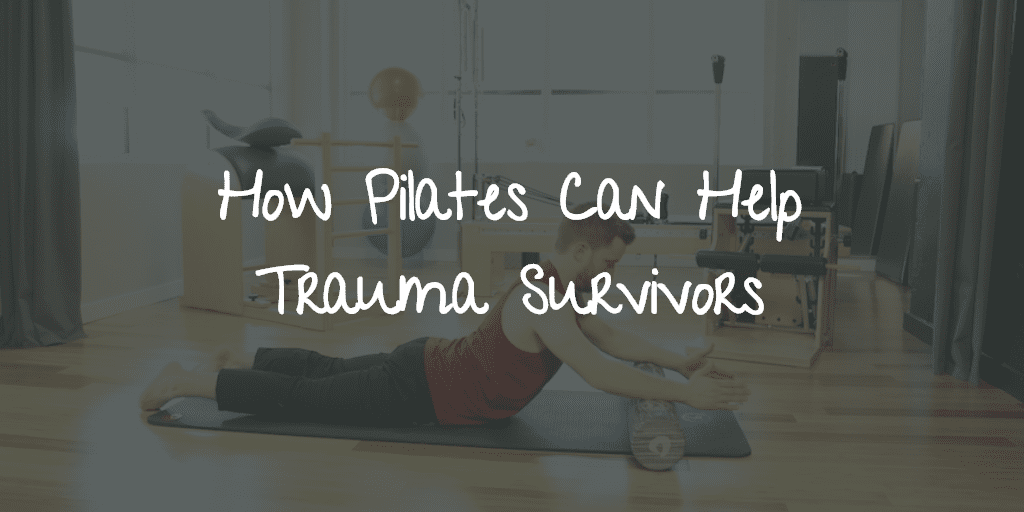
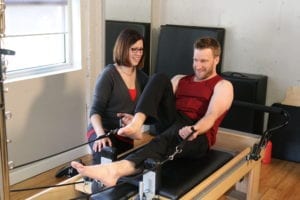 It is empowering to be reminded how our body works, how strong it can become, and how resilient it can be. Pilates exercise helps to increase this awareness as muscle groups are discovered and isolated in exercise. Pilates aids in building core strength from within that, in turn, enables even more powerful and controlled movement.
It is empowering to be reminded how our body works, how strong it can become, and how resilient it can be. Pilates exercise helps to increase this awareness as muscle groups are discovered and isolated in exercise. Pilates aids in building core strength from within that, in turn, enables even more powerful and controlled movement. While Pilates offers mind-body benefits, it will also challenge your body as you work through exercise. A stronger core and back result from training focused on deep abdominal muscle groups near the spine. The strength gained starts from the core but soon transitions to building long, lean muscle and improved flexibility throughout the body.
While Pilates offers mind-body benefits, it will also challenge your body as you work through exercise. A stronger core and back result from training focused on deep abdominal muscle groups near the spine. The strength gained starts from the core but soon transitions to building long, lean muscle and improved flexibility throughout the body. Here are just a few of the Firehaus Pilates exercises that assist clients to both understand their body mechanics and also help ease back pain by improving strength, flexibility, and posture.
Here are just a few of the Firehaus Pilates exercises that assist clients to both understand their body mechanics and also help ease back pain by improving strength, flexibility, and posture. For all aspects of Pilates exercise, participants are encouraged to practice a neutral spine position. This powerful principle helps improve posture and increase mindfulness on how we move and use both our back and core muscles.
For all aspects of Pilates exercise, participants are encouraged to practice a neutral spine position. This powerful principle helps improve posture and increase mindfulness on how we move and use both our back and core muscles.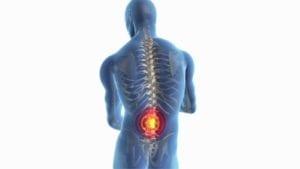 Many Pilates exercises can help alleviate back pain, but all begin with these basic movements that facilitate identifying and concentrating on the spine and core. As clients achieve this improved focus and increase strength,
Many Pilates exercises can help alleviate back pain, but all begin with these basic movements that facilitate identifying and concentrating on the spine and core. As clients achieve this improved focus and increase strength,